Class 10 Human Eye and Colourful World Notes
Notes Previous Years Questions Important Questions MCQ Quiz – 1Human Eye and Colourful World Notes
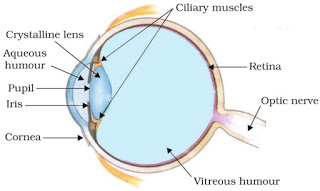
- Human eye ball is approximately spherical in shape with diameter of about 2.3 cm.
- Light enters the eye through a thin membrane called the cornea.
- Iris controls the size of pupil.
- Pupil regulates the amount of light entering the eye.
- Image is formed on retina & its nature is real & inverted.
- The retina has two types of light sensitives cells i.e., rods & cones.
- Rods are responsible for vision at low light.
- Cones are active at higher light levels & is responsible for colour vision.
- Ciliary muscles help to change the focal length of the eye lens.
- Blind spot:- The junction of retina and optic nerve where no light sensitive cells are present is called blind spot.
Power of accommodation:-
The ability of eye lens to adjust its focal length with the help of ciliary muscles is called power of accommodation.
- When the ciliary muscles relax, the eye lens becomes thin and its focal length increases.
- When the ciliary muscles contract, the eye lens becomes thicker and its focal length decreases.
Least distance of distinct vision (near point):-
The minimum distance at which objects can be seen clearly without strain is called least distance of distinct vision.
- Near point for a normal human eye:- 25 cm
Far point:-
The farthest point up to which the eye can be see objects clearly is called far point.
- Far point for a normal human eye:- Infinity
- Range of vision:- 25 cm to infinite.
Cataract:-
Sometimes, the crystalline lens of people at old age becomes milky & cloudy, this condition is called cataract.
- In this case, vision can be restored through cataract surgery.
Defects of vision:-
Myopia (near-sightedness):-
The type of defect in which a person can see nearby objects clearly but cannot see far objects distinctly is called myopia.
Causes:-
- Excessive curvature of eye lens (decrease in focal length).
- Elongation of the eyeball.
Correction:-
Myopia is corrected by using concave lens of suitable power.
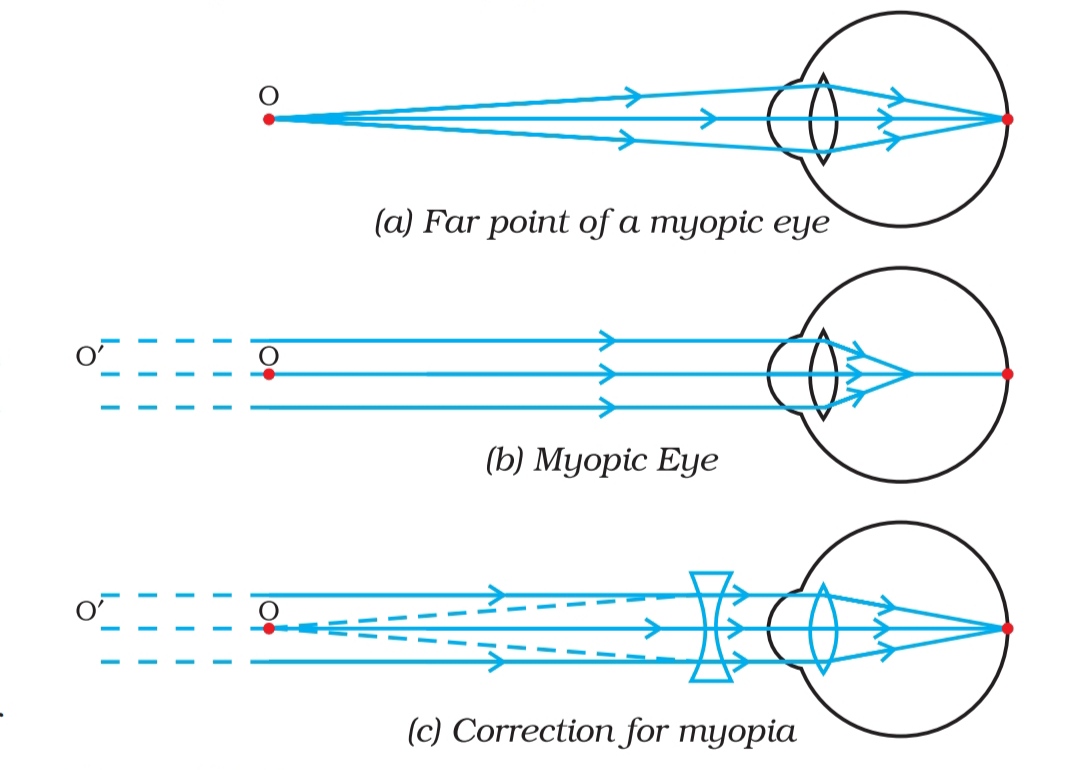
Hypermetropia (far-sightedness):-
The type of defect in which a person can see distant objects clearly but cannot see nearby objects distinctly is called hypermetropia.
Causes:-
- Increase in focal length.
- Decrease in the size of eyeball.
Correction:-
Hypermetropia is corrected by using convex lens of suitable power.
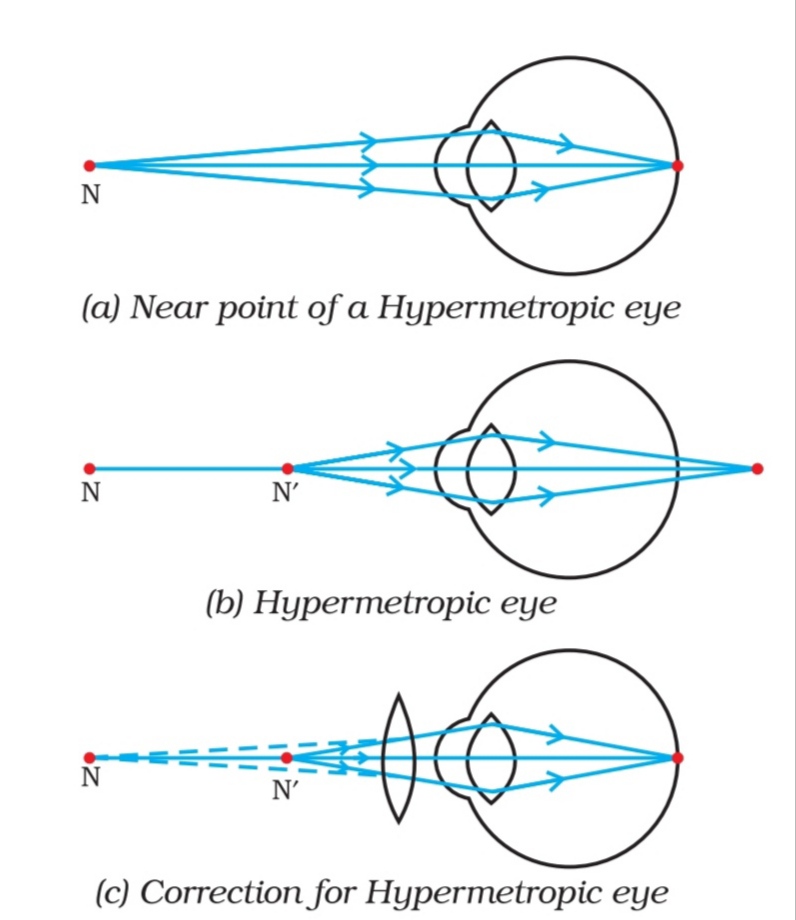
Presbyopia:-
The type of defect in which a person at old age cannot see nearby objects as well as distant objects clearly is called presbyopia.
Causes:-
- Weakening of ciliary muscles.
- Decrease in flexibility of eye lens.
Correction:-
It can be corrected by using bi-focal lens in which upper part is concave lens & lower part is convex lens.
Refraction of light through glass prism:-
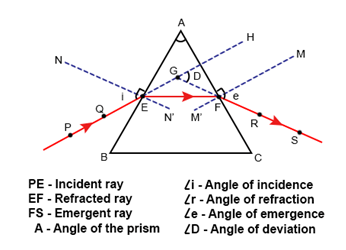
Angle of prism:- The angle between two lateral faces of the prism is called angle of prism.
Angle of deviation:- The angle between incident ray & emergent ray in a prism is called angle of deviation.
Dispersion of light:- The splitting of white light into its component colours is called dispersion of light.
Spectrum:- The band of seven coloured components of light is called spectrum.
Dispersion of white light by a glass prism:-
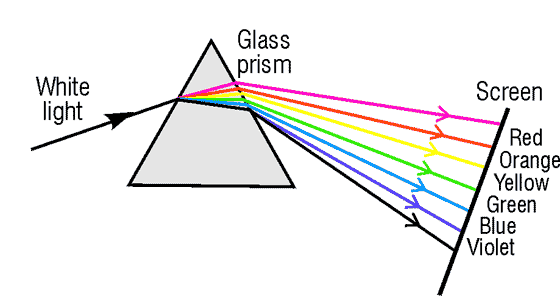
- When Newton placed a second identical prism in an inverted position with respect to the first prism, he found a beam of white light emerging from the other side of the second prism. This shows that sunlight is made up of seven colours.
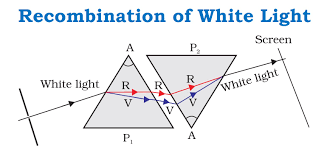
Rainbow Formation:-
It is a natural spectrum appearing in the sky after a rain shower. A rainbow is always formed in a direction opposite to that of the Sun.
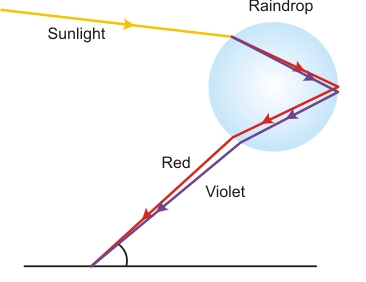
Three phenomena which are involved in rainbow formation are:-
- refraction
- dispersion and
- total internal reflection
Atmospheric Refraction:-
The refraction of sunlight by different layers of atmosphere is called atmospheric refraction.
Phenomena caused by atmospheric refraction:-
Apparent position of star:-
The refractive index of earth’s atmosphere increases from top to bottom. So, the light coming from a star near the horizon has to travel from rarer to denser medium & it bends towards the normal. As a result the star appears higher than its actual position.
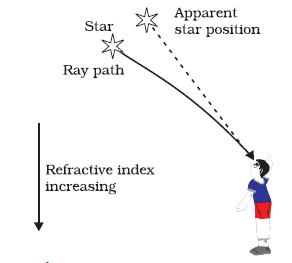
Twinkling of stars:-
Since the physical conditions of the earth’s atmosphere are not constant, so the light from stars appears to come from different directions. This results in fluctuation of apparent position of star. Also the amount of light coming from stars vary due to changing refractive index of atmosphere. So the stars sometimes appear brighter and sometimes fainter. These two effects are responsible for twinkling of stars.
Advanced sunrise and delayed sunset:-
When the sun is below horizon, the rays have to pass from rarer to denser medium. So rays bend towards normal. As a result, the sun appears higher than its actual position. So the sun rises two minutes earlier than actual sunrise and remains visible for about two minutes after the actual sunset.
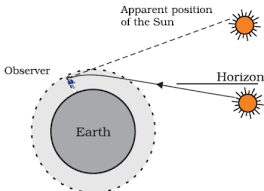
Phenomena based on scattering of light:-
Tyndall effect:- The phenomenon of scattering of light by colloidal particles so that its path becomes visible is called tyndall effect.
Blue appearance of the sky:-
The upper layer of atmosphere contains very fine particles. These particles are more effective in scattering light of shorter wavelength mainly upto blue end. These scattered light enter our eyes and the sky appears blue.
Reddish appearance of the sun at sunrise and sunset:-
During sunset and sunrise, the sun is near horizon and the the sunlight has to travel larger distance in atmosphere. Due to this most of the light of shorter wavelengths are scattered away by the particles and light of longer wavelengths reaches our eyes. This gives reddish appearance of the sun at sunrise and sunset.
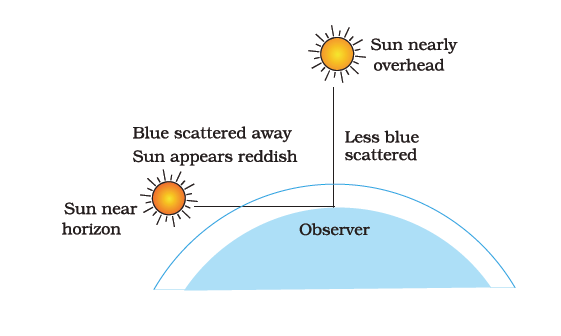


Comments